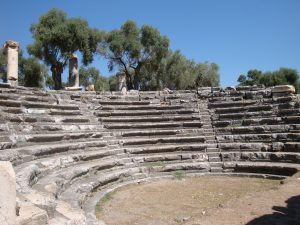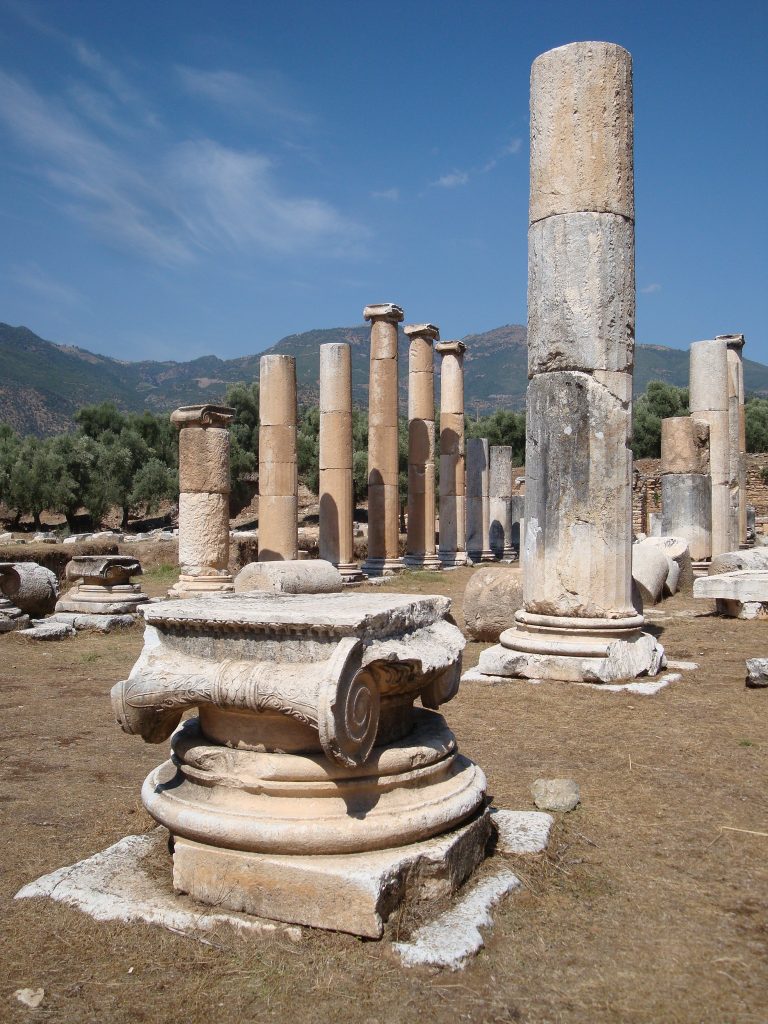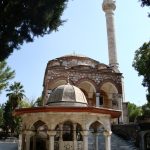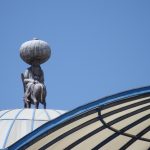Old name: Athymbradus, Nysa ad Maeandrum
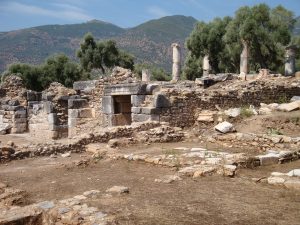 Thirty-four km east of Aydın, the ruins of ancient Nysa stand in splendid isolation on the hills above the small town of Sultanhisar. While visitors pour into Ephesus and Aphrodisias in their thousands, few make it to Nysa – which is just how most of them would like it to stay.
Thirty-four km east of Aydın, the ruins of ancient Nysa stand in splendid isolation on the hills above the small town of Sultanhisar. While visitors pour into Ephesus and Aphrodisias in their thousands, few make it to Nysa – which is just how most of them would like it to stay.
But archaeological sites are best protected by their visitors and poor Nysa was robbed of some of the magnificent carvings that used to provide the backdrop to its ancient theatre no doubt because so few people ever come here.
Backstory
On the slopes overlooking a ravine, Nysa rose to prominence under the Romans and was home for a while to the historian Strabo (63 BC-AD 25), a serendipitous circumstance that means we have a better written description of what the city looked like in its prime than we have for most other ancient Anatolian settlements. Strabo described it as three towns rolled into one and said that it was originally called Athymbradus after three Spartan brothers named Athymbrus, Athymbradus and Hydrelus.
Perhaps that was a name that didn’t trip off 1st-century tongues any more than it trips of those of modern visitors because by the second century the settlement appears to have been renamed Nysa, possibly in honour of the wife of King Antiochus I Soter. Nysa became an important educational centre with an outlying health resort called the Charonium near what is now the village of Salavatlı.
But it was perhaps that little bit too close to the major settlement at Tralles, above modern Aydın, and slowly but surely the hillside site was abandoned in favour of what is now Sultanhısar. The great thing about that change of location is that it left the ruins of the original settlement virtually undisturbed. Today they spill out amid the olive groves on the slopes of Malkaç Dağı (Mt Messogis, 875m), abandoned to the skylarks and the occasional more enterprising tourist.
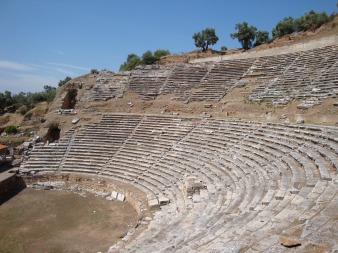 Around the site
Around the site
It’s not hard to get to Nysa since regular buses (and a few trains) from Aydın travel to Sultanhisar, a sleepy little town whose inhabitants mainly make their living from farming. The ruins lie scattered about the hillside 3km above the town which means that you can easily walk there if it’s not too hot.
Just past the ticket office work has begun on rebuilding some of the structures in an effort to lure in more people. Then as you walk towards the theatre which lies at its heart you will pass on your right the tiered seats of what was once an amphitheatre precariously perched on the sides of the hill to take advantage of a stunning view out over the floodplain.
In its heyday apparently all sorts of entertainments took place on a stage balanced over the Tekkecik Çayı, a stream that ran along the bottom of the ravine. Most impressive were the reconstructed naval engagements during which the arena was actually flooded using water drawn up from the stream. A bridge spanned the ravine while a 115-metre-long tunnel rather like the tunnel of Vespasian in Çevlik, south of Antakya, ran back behind it; the bridge is gone apart from its struts but the tunnel is hanging on in there, still serving its dual function as a storm-drain and a support structure for the theatre above.
But it’s the theatre that is the real jewel in Nysa’s crown. Capable of accommodating a capacity crowd of around 12,000 in 35 rows of marble seats, it survives largely intact above the tunnel. The same is equally true at many other Turkish archaeological sites, of course but what makes Nysa so particularly special is that many of the carvings that used to decorate its stage also survive when elsewhere they have long since fallen prey to the vagaries of time.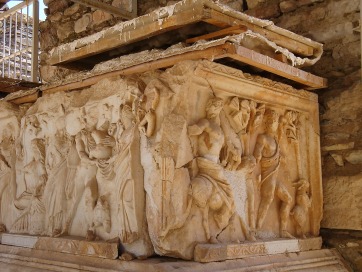
But the sad truth is that the same isolation that some visitors will find so appealing has cost Nysa dearly, because even these carvings were a great deal more intact until October 2005 when, under cover of darkness, persons unknown descended on the site and took an axe to the images (this was not the first attack – other pieces had been stolen in 1995 – but on this occasion the assailants appear to have crudely destroyed rather than simply removed the sculptures, focusing their attention in particular on the faces).
These priceless but now sadly damaged works of art are now caged behind bars as sculptors work on conserving them, while the bureaucrats talk about moving them to a place of safety in Aydın. In the meantime you can peek through the bars at an astonishingly beautiful sequence of carvings that mostly relate the life story of Dionysius, the Ancient Greek god of wine and partying. To look on them is to realise that despite the austerity of the seating arrangements spectators would once have gazed down on a wall of ornamentation of almost baroque exuberance.
You’ll probably have trouble tearing yourself away from the theatre but a short walk round to the far side of the ravine will bring you to the glorious site of the ancient agora where a handful of columns have been picturesquely re-erected.
Nearby it would be easy to miss the second major attraction at the site since it lurks behind an enclosing wall. The almost perfectly preserved bouleterion would usually be described simply as a council chamber but in this particular case Strabo described it as a Gerontikon, or a place where the elders would have gathered, six to eight hundred of them at a time. A theatre-in-miniature, it consists of 12 rows of marble seats grouped in a semi-circle and facing a small stage where speakers would have held forth.
The doorposts are carved with bull’s heads and swags of marble foliage. Despite the silence, it feels almost as if you might hear the rustle of white togas as the councillors settle themselves down on the benches in front of you.
Nysa’s third gem is back on the other side of the ravine where a flight of uneven steps lead up to a stretch of cobbled Roman road striking out into the olive groves. To the left, a side street branches off towards an open-fronted library that has been described as “the most important in Anatolia after the library of Celsus at Ephesus.” Here books were once lovingly shelved in niches with spaces for air left open at the back so that they wouldn’t grow mouldy in the high humidity of summer.
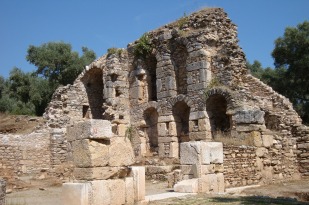 LibraryThere’s probably much more to be uncovered at Nysa when and if funds permit. But near the exit you should pause to inspect one last relic of the past: the excavated remnants of a Byzantine church dating back to the period when Nysa had become the seat of a bishopric. On the hillside across the road there are traces of an extensive necropolis (burial ground) where tombs were arranged in neatly-aligned tiers.
LibraryThere’s probably much more to be uncovered at Nysa when and if funds permit. But near the exit you should pause to inspect one last relic of the past: the excavated remnants of a Byzantine church dating back to the period when Nysa had become the seat of a bishopric. On the hillside across the road there are traces of an extensive necropolis (burial ground) where tombs were arranged in neatly-aligned tiers.
The finds from Nysa are mainly on display in Aydın Museum.
Sleeping
Most people will want to visit Nysa on a day trip from Aydın. However, there is one good hotel on the hillside near the ruins.
Nysa Otel. Tel: 0256-351 2222
Transport info
There are regular minibus services from Aydın town-centre local bus station to Sultanhisar. Taxis wait at the junction to run people up to the ruins. You can walk back or make an arrangement to be picked up once you’ve finished exploring.
